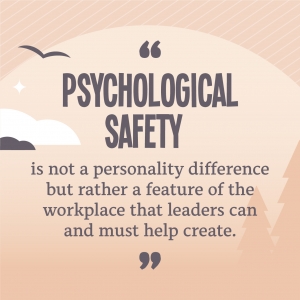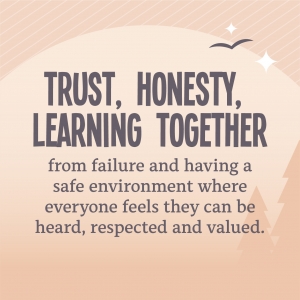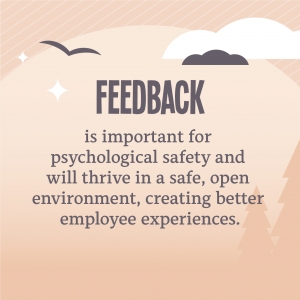Toby’s got an idea.
It’s a good one. He’s excited. He’s confident it’ll help. Save time. Make jobs easier. Trim team spend.
He knows what he’s doing. He’s been working in the company for 4 years and he’s learned a lot.
He’s on the Teams meeting, coffee in hand, waiting anxiously and excitedly for the perfect moment to share his thoughts.
But Toby’s heart begins to race. His palms start to sweat. His stomach flips. He panics. And Toby’s idea slinks away sadly, failing to make the difference it could have.
What happened? Was Toby nervous? Stupid? Incompetent? No. Toby didn’t feel comfortable sharing his thoughts because he feared he might be shut down, even ridiculed. In Toby’s team, there was a distinct absence of psychological safety. It wasn’t just Toby who suffered. Katy felt the same. So did Steph. Team members felt a fear of reprisal, judgment, even shame if they spoke up because they’d seen it all too many times before. So most of the time, they chose to keep their heads down and remain quiet. A risk-free existence.
The meaning and value of psychological safety at work
Amy Edmondson, organisational behavioural scientist and author of The Fearless Organisation, defines the notion of psychological safety as,
“A shared belief held by members of a team that the team is safe for interpersonal risk-taking, a belief that one will not be punished or humiliated for speaking up with ideas, questions, concerns or mistakes.”
Edmondson observes that psychological safety “is not a personality difference but rather a feature of the workplace that leaders can and must help create.”
 So how can leaders, at all levels, create comfortable environments and foster behaviours that help people feel safe to speak up, share ideas, make a difference? Communication plays a key part…
So how can leaders, at all levels, create comfortable environments and foster behaviours that help people feel safe to speak up, share ideas, make a difference? Communication plays a key part…
-
Show appreciation for input
The way we respond when people share their ideas is critical to creating a psychologically safe environment. People can be permanently discouraged if others don’t respond to input in the right way. A good place to start is simply showing appreciation and thanking people for their ideas. It feels like a small thing, but had Toby been thanked for previous contributions, he may have been more willing to speak up and share his money-saving idea this time round.
-
Define your ‘tent time’
We attended an inspiring session by the brilliant Dr Ed Coats, polar explorer, adventurer and Specialist Registrar in Obstetrics & Gynaecology. He spoke about the value of honesty, learning together from failure and having a safe environment where everyone feels they can be heard, respected and valued.

During expeditions, he and his team would gather in their tent, surrounded by snow in the freezing polar landscape, to discuss whatever was on their minds. They created a safe, open and honest environment for people to talk. And it created a seismic shift in their team dynamic. Mimic these moments by creating regular ‘tent time’ where anything goes, and people can safely share their thoughts and ideas. It might only take ten minutes but it’s a powerful habit to cultivate.
-
Pair up
The book, No Hard Feelings, by Liz Fosslien and Mollie West Duffy describes how people feel more trusting when they talk to a single person versus the whole room. Use break-out tools for virtual sessions – start meetings with a five-minute ice breaker, in which one person shares a challenge they’re currently tackling and the other offers ideas to help overcome it. People like Toby, Katy and Steph will begin to feel comfortable not only sharing the things that are testing them but also offering each other ideas and solutions to solve them.
-
Practice proactive inquiry
Make it ok to not have all the answers and be comfortable with saying you don’t know. Because showing vulnerability is a key element of a psychologically safe environment. According to Elizabeth Lyle, partner at Boston Consulting Group and expert on creating high-performance teams,
“Leaders should create an environment where people feel encouraged to ask for input and information and to share their ideas and solutions.”
She adds, “We think that career currency is always having the answer. But in fact, we may just not know the answer, or we may have not thought about it yet.”
Let team members like Toby know that all thoughts and ideas are valued and directly encourage input. During conversations, try asking some of the following questions or posing these conversation starters:
- ‘I’m struggling with this part of the project. Could you help me?’
- ‘So, this didn’t go quite to plan! But here’s what I learned…’
- ‘What ideas do you have to approach this challenge?’
-
Be More HIP
Radical Candor, devised by Kim Scott and Jason Rosoff, is an approach to feedback that is all about caring personally while challenging directly. At its core, Radical Candor is guidance and feedback that’s both kind and clear, specific and sincere.
 Feedback is incredibly important for psychological safety and will thrive in a safe, open environment with stronger more trusting relationships, more opportunities for risk-taking and learning from mistakes creating better employee experiences. Here’s a way to think about how to be more kind and clear with criticism and more specific and sincere with praise.
Feedback is incredibly important for psychological safety and will thrive in a safe, open environment with stronger more trusting relationships, more opportunities for risk-taking and learning from mistakes creating better employee experiences. Here’s a way to think about how to be more kind and clear with criticism and more specific and sincere with praise.
Practice being HIP with your feedback:
- Humble
- Helpful
- Immediate
- In person
- Private criticism / Public praise
- Not about Personality
This will help to improve work relationships and connections and can be practiced between peers as well as by leaders and managers. This HIP article explains more.
In summary
These 5 practices could make a world of difference for Toby, Katy and Steph, helping them to feel safe sharing the knowledge that’s so critically valuable to their organisation. That’s a win-win result. None of them cost a penny, and all can be achieved through virtual channels if needed. By finding ways to build them into daily practices, we can create that safe space for employees to thrive.
















